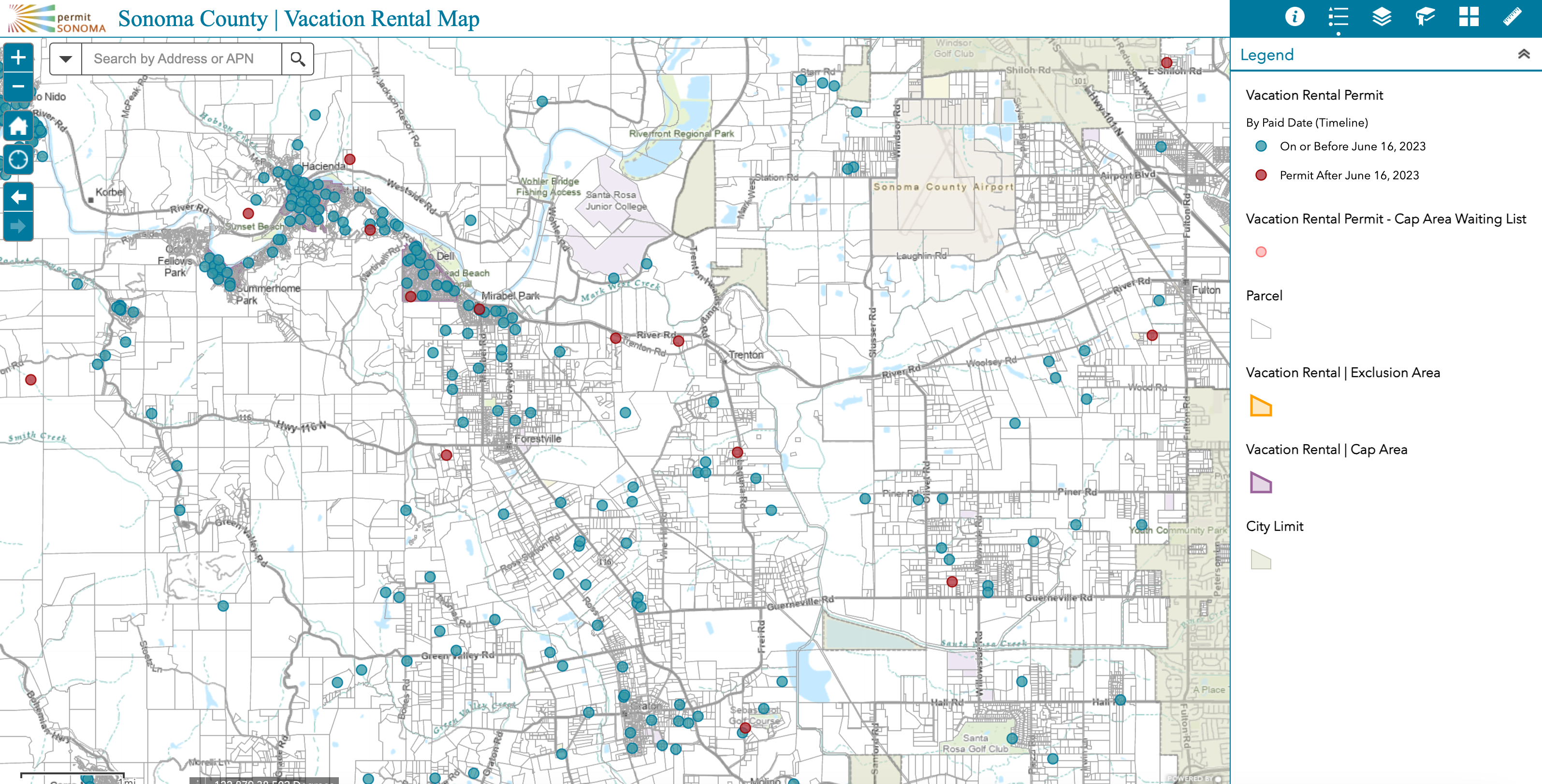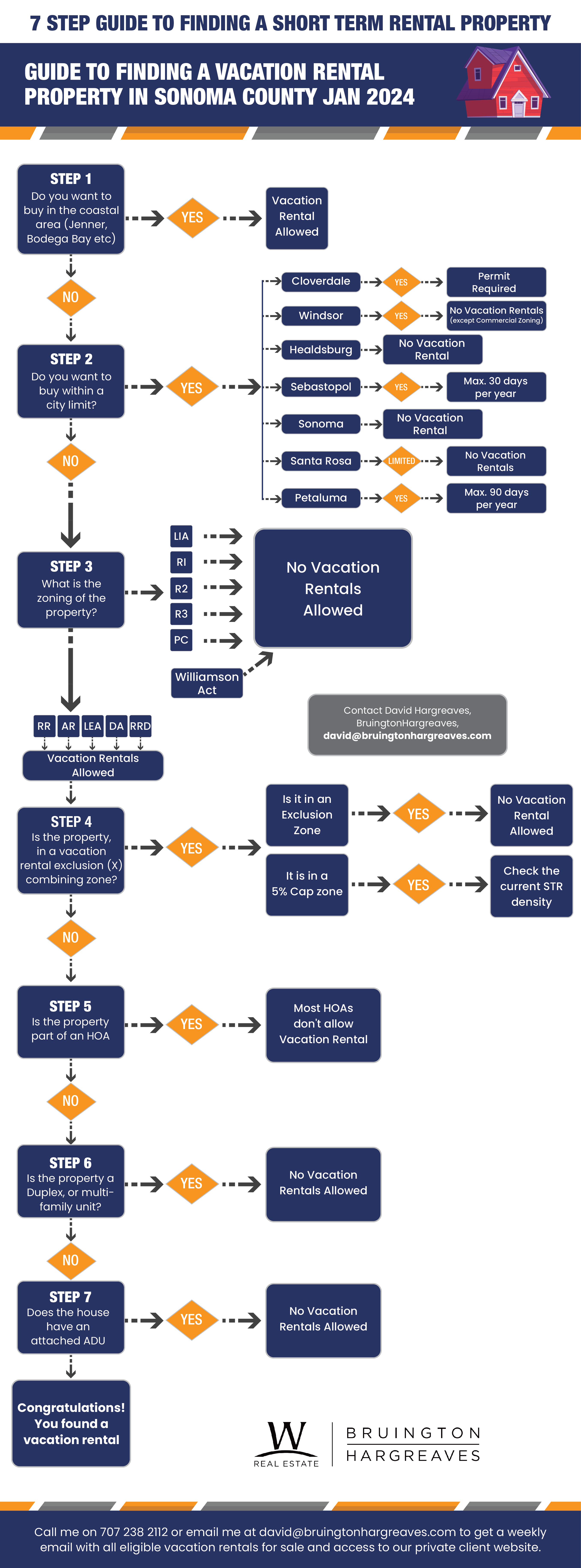In August 2023, Sonoma County introduced a new vacation rental ordinance and a new requirement for a business license. So what are the Sonoma County vacation rental regulations? How do you determine if a property is eligible to be operated as a whole house vacation rental? It is important to note that whenever a home is sold, it automatically loses the ability to be operated as a vacation rental without the new owner successfully applying for a new vacation rental permit. Whether you want to know how to find a qualifying property to purchase or if you just want to know “Can I rent my property short term in Sonoma County?”, this streamlined guide covers the seven key steps (which we also put into a simple graphic- see below) any homeowner or investor should follow to determine if a property can be operated as a vacation rental
1. Coastal Region Consideration
Firstly, identify if the property is located within the coastal region. All single family homes in this area can be vacation rented, but starting later in 2024, both a license and a permit will be required. However, these coastal properties will not face zoning restrictions, so regardless of the underlying zoning, a property you will be able to operate a property as a vacation rental.
It is worth noting that for someone operating a vacation rental with a TOT number before October 26, 2023 the only thing needed is a license but the license does not have a septic or zoning requirement. No permit will be required.
Once the coastal commission votes for the coastal plan then a permit and license will be required for any new STR operators. The permit will have the same requirements as inland regarding septic capacity, parking and permitted bedroom count (see the requirements below)
2. City Limits Check
Determine whether the property falls within the limits of specific cities. In Windsor, Healdsburg, Sonoma, and Santa Rosa, no new vacation rentals are now allowed, with few exceptions for properties with specific commercial zonings. Sebastopol limits vacation rentals to 30 days per year, while Petaluma allows up to 90 days annually for whole house rentals. Hosted rentals, however, are permitted across these cities, offering an alternative route for property owners who are happy to host guests with a limit on renting out no more than one or two bedrooms.
3. Sonoma County Vacation Rental Zoning Restrictions
What are the Sonoma County Vacation Rental Zoning Restrictions? One of the big requirements is to ensure that the underlying zoning of a property allows it to be vacation rented. The key permitted zonings to look out for in Sonoma County un-incoroproated are RR, AR, LEA, DA and RRD. Properties zoned LIA, R1, R2, R3, and PC are ineligible to be operated as a vacation rental by a new owner. It is worth noting that it is not possible to vacation rent any property that is under the Williamson Act. This step is vital to understand the eligibility of any property that is in Sonoma County unincorporated. The best way to determine this is to go to the county website zoning look up, put in the address and then you can see what the zoning is. Here is the county zoning look up site
4. Exclusion and Cap Zone Analysis
One of the big changes that came in in August of last year was the extension of the exclusion zones into different areas of the county as well as the introduction of a number of areas where a new cap of 5% was introduced. This essentially limits the number of vacation rentals in the designated cap areas to no more than 5 per cent of the housing stock within the boundaries of the zone. As of February 2024, there are no cap zones which have available capacity for a new vacation rental because they have all exceeded their 5% density limits, effectively pausing the issuance of new vacation rental permits in these areas. There are a couple of areas where the density is at 7 or 8 percent. Even at these levels it could take a couple of years for enough properties to sell to free up capacity for a new vacation rental.

If you would like to see a detailed breakdown of where all the exclusion zones and cap areas are within the county, then please take a look at this blog post I wrote when the new rules were announced where I highlight all the exclusion and cap areas. There is also a map on the Sonoma County website that shows where all the different zones are as well as highlighting the address of every active permit in the county.
5. HOA Restrictions
You also need to assess if the property is part of a Homeowners' Association (HOA). The vast majority of HOAs prohibit vacation rentals, which can be a decisive factor in determining a property's eligibility for such use. There are some areas which have CCRs in place but there is no HOA to enforce them. For example there is an area in Bennett Valley where this is the case and I do know that there are a couple of vacation rentals operating.
6. Multi-Unit Zoning Consideration
If the property is zoned as a duplex, triplex, or multi-family dwelling, it is not eligible to be a vacation rental. This criterion ensures that residential properties designed for multiple families are preserved for long-term housing.
7. JADU Implications
A property with a permitted attached Junior Accessory Dwelling Unit (JADU) is ineligible for vacation rental use. This regulation aims to maintain the availability of these smaller, attached units for residential purposes rather than short-term accommodations. It is also worth noting that an ADU cannot be vacation rented, legally.
Congratulations You Found One!
A property that successfully navigates these seven steps without falling foul of the outlined restrictions is eligible to get a vacation rental permit. For every single property that comes on the market, we run the property through all these checks and if it qualifies we put it on a private website that we share with clients. If you want to get access to that website, get in touch with me.
Avoiding Common Pitfalls: Tips For Finding Your Vacation Rental Property
There is one more step in the process that we always check for client during the course of escrow. Given most properties in Sonoma County unincorporated are on a septic system, it is important to ensure that the property has a septic permit on file at the county and also to understand how many bedrooms the septic permit is for. If you have a house that is sold as a 4 bedroom home but only has a 3 bedroom septic permit, you will only be able to get a 3 bedroom vacation rental permit.
If the home doesn’t have a septic permit on file, it doesn’t mean you can’t vacation rent it, it just means that you have to go through a process with the county to complete a Finding Report. This involves getting a septic inspector to verify what septic system is in place and map it. While not a problem in its own right it just costs time and money. It could cost a couple of thousand dollars and take up to six months to go through the entire process with the county.
Requirements of the Business License
While you don’t need to worry about the requirements of the business license prior to purchasing you do need to ensure that the property has on-site parking. For example if you are applying for a two bedroom vacation rental permit you will need one on-site parking space. Two on-site parking spaces are required for a three or four guestroom vacation rental.
The other requirements of the business license are focussed on setting and enforcing operating standards for the running of the vacation rental once an owner gets the permit. For example, to comply with noise restrictions, outdoor amplified sound is generally prohibited. This measure helps ensure that vacation rentals do not disrupt the peace and tranquility of residential neighborhoods.
Sonoma County vacation rental occupancy limits were also changed last year. Overnight occupancy for vacation rentals shall be up to a maximum of two people per sleeping room plus two additional persons per property, up to a maximum of twelve people. For example if you have a three bedroom vacation rental permit you can advertise the property as “3 bedrooms, sleeps 8.”
While not limited to vacation rental home owners, there is a requirement to ensure defensible space around the property is maintained to reduce the risk of fire spread, complying with Sonoma County's guidelines for vegetation management and fire safety. The business license outlines specific requirements for outdoor lighting which must not be obtrusive to neighbors and should adhere to lumens limits per fixture. While it’s important to adhere to these once you are operating the vacation rental, they don’t really factor into the purchase decision for a particular property. That being said, it is always worth investigating how many of the neighboring properties are vacation rentals and how many are primary homes.
In Summary
To find an eligible property you just need to work through the seven steps outlined above, or sign up here to get access to my private website where I list all eligible properties. As long as you don’t want one in the city limits, then there are lots of options to find a property that complies with the Sonoma County vacation rental regulations at pretty much all price points. Since the latest changes last year, the sub $800k market has got tougher because a lot of those homes are either in the Russian River or else they are zoned R1 which are no longer eligible. That being said, there are still options, you just need to know where to look.
Other Useful Resources:
Here are all our Vacation rental blogs: https://www.modernlivingsonoma.com/category/vacation-rental/
Seven Vacation Rentals Our Clients Set Up That We Love
The Secrets Of Setting Up A Profitable Vacation Rental
Sonoma County's Best Performing Vacation Rentals
A Map Of All Active Vacation Rentals In The County










